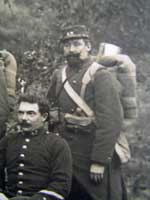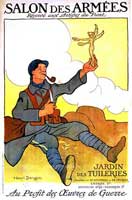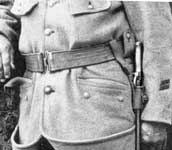France: Modèle 1914 Equipment d'Infanterie de Sangles
Introduction

 Karkee Web are indebted to Simon Braillon for the photo of the 43e Regiment (left). This has to be the shortest interval between actual items being seen in photographs and a contemporary photograph emerging, thoughtfully captioned by the unit involved, the 43e Régiment d'Infanterie, on the 8th November 1914. La Courtine is a small village in the Creuse Département, of the Limousin Region of Central France. In 1904, a military camp had been established there, capable of housing 4,000 soldiers. The photo is important, not just for proof that a second webbing pattern was used by the French Army, but for the details that could be observed and speculated upon. However, this done, more photographs of surviving items surfaced, confirming the speculated points – and it revealed it was a blue-grey webbing. Unguessed, was the fact that the Pack opened flat – very much not French practice!
Karkee Web are indebted to Simon Braillon for the photo of the 43e Regiment (left). This has to be the shortest interval between actual items being seen in photographs and a contemporary photograph emerging, thoughtfully captioned by the unit involved, the 43e Régiment d'Infanterie, on the 8th November 1914. La Courtine is a small village in the Creuse Département, of the Limousin Region of Central France. In 1904, a military camp had been established there, capable of housing 4,000 soldiers. The photo is important, not just for proof that a second webbing pattern was used by the French Army, but for the details that could be observed and speculated upon. However, this done, more photographs of surviving items surfaced, confirming the speculated points – and it revealed it was a blue-grey webbing. Unguessed, was the fact that the Pack opened flat – very much not French practice!
Simon has personally tagged it as Deuxieme Modèle Mills, the unsuccessful Mills-Bruzon set being La Premiere Modele Mills. Production is reported to have been to meet the emergency of late 1914, so it would not be un-reasonable to steal the U.K. “emergency” pattern’s identity and refer to it as Modèle 1914 Equipment d'Infanterie de Sangles!
 In 2005, Martin Brayley’s book BAYONETS: AN ILLUSTRATED HISTORY contained a photo of a poilu dressed in an horizon-bleu greatcoat, over which was a 2.25-inch wide Waistbelt, in flat-loop belting, with the U.S. style loop and olivet buckle and French style Frog, but in webbing. At the time, we had no idea what pattern this could be, or whether what the photo showed was the whole pattern, i.e. just a Belt and Frog for a Drill Order, or Walking Out. Now, with the benefit of Simon’s photos and those from Eric Baradon, the complete picture has emerged. The owner of the photograph shown in Martin's book, Robert Stedman, has graciously allowed us to use it here as well. However, he has asked that it not be copied, please.
In 2005, Martin Brayley’s book BAYONETS: AN ILLUSTRATED HISTORY contained a photo of a poilu dressed in an horizon-bleu greatcoat, over which was a 2.25-inch wide Waistbelt, in flat-loop belting, with the U.S. style loop and olivet buckle and French style Frog, but in webbing. At the time, we had no idea what pattern this could be, or whether what the photo showed was the whole pattern, i.e. just a Belt and Frog for a Drill Order, or Walking Out. Now, with the benefit of Simon’s photos and those from Eric Baradon, the complete picture has emerged. The owner of the photograph shown in Martin's book, Robert Stedman, has graciously allowed us to use it here as well. However, he has asked that it not be copied, please.
 There are ink-stamps, of typical French form, but no markings for M.E. Co., or the bullet trademark of M.W.C.B. Co. It is therefore thought that this pattern was made up in France, using stocks of material delivered from the U.S.A., unless it can be shown that the French company, Le Coton Filé, had the capability for both reduction weaving and integral weaving. A faint larger stencil, on some items, appears to say “R.F.”, for Republique Francaise. Detail at left from an Ammunition pouch in the collection of Simon Braillon. Photograph © Simon Braillon 2010.
There are ink-stamps, of typical French form, but no markings for M.E. Co., or the bullet trademark of M.W.C.B. Co. It is therefore thought that this pattern was made up in France, using stocks of material delivered from the U.S.A., unless it can be shown that the French company, Le Coton Filé, had the capability for both reduction weaving and integral weaving. A faint larger stencil, on some items, appears to say “R.F.”, for Republique Francaise. Detail at left from an Ammunition pouch in the collection of Simon Braillon. Photograph © Simon Braillon 2010.
Simon has established that this Pattern was intended for training units, with no evidence of it reaching front-line troops, but the possibility that French Territorial units may have taken into field service. Apparently, all the French “Mills” items were issued to the 1er Corps d'Armée, comprising eight Régiments d’Infanterie (R.I.) of northern France, these being 8e. R.I. de St. Omer; 33e. R.I. d'Arras; 43e. R.I. de Lille; 73e. R.I. de Béthune; 84e. R.I. d'Avesnes; 110e. R.I. de Dunkerque; 127e. R.I.de Valenciennes and also the Territorial régiment that was attached to these.
 KWRT member, Ed Storey, has also furnished details below from his French contacts, which set this un-expected Model into a context:-
KWRT member, Ed Storey, has also furnished details below from his French contacts, which set this un-expected Model into a context:-
The Mills-Bruzon Equipment was tested by the French in 1908 and 1912, but none were ordered. Mills opened a subsidiary company in Paris, in 1914 (Le Coton Filé) but it only received very small orders during the emergency of late 1914. Another Mills branch, Société Anonyme Française pour l'Equipement National (SAFEN), opened in April 1918, with not much more success and closed down in 1920. Apparently the French Army did not see any advantage in webbing, did not want to pay royalties and the leather industry had to be protected. Furthermore, France did not produce cotton, which would have been a major problem.